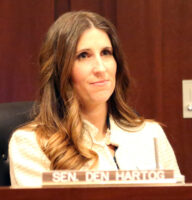Based on the experience in other states, it could take three to five years for Idaho to rewrite its school funding formula.
And based on Tuesday’s hearing, a panel of Idaho lawmakers doesn’t seem to be much interested in a rush job.
Members of the Legislature’s Public School Funding Formula Committee made a couple of incremental decisions. They will ask a second legislative committee to spend the next few months looking at health care costs — a growing financial issue for school districts. They assigned legislative staff to pull together some additional data. And they agreed to meet again on Aug. 14.
The pace is slow. But the stakes are high.
The funding formula is the complicated and delicate mechanism that the state uses to carve up dollars for K-12. At nearly $1.7 billion in 2017-18, K-12 represents by far the biggest chunk of the state’s budget. But the formula hasn’t been reworked since 1994. That has forced legislators to shoehorn a host of new programs — from classroom technology to charter schools to 21st Century staffing demands — into a 20th Century funding blueprint.
At some point, if the state decides to redistribute its existing K-12 dollars, some districts and charters will collect more money, while others could absorb a funding hit.
The funding formula committee isn’t close to picking winners and losers, at least not yet. The committee might have computer-generated models and recommendations for the 2018 Legislature, but that’s not a hard and fast timetable. And it became no clearer Tuesday.
For much of the day, the 10-member committee heard from Daniel Thatcher, a national school finance expert with the Denver-based National Conference of State Legislatures. Thatcher provided lawmakers with a long view of state school funding — dating back to the Old Deluder Satan Law, the 1640s Massachusetts colonial law that called for parents to pay for their children’s education.
He also walked legislators through the current state of funding law. Attempts to tie funding formulas to student performance have been mixed. However, in the aftermath of a 1993 court case, modern-day Massachusetts adopted an outcomes-based approach to the funding blueprint. “It seems to have helped,” Thatcher said.
In rewriting its funding formula, Idaho has a chance to align dollars to its priorities — such as its overriding goal, ensuring that more high school graduates are college- and career-ready. At the same time, Thatcher cautioned against ducking the tough and politically sensitive questions. When California rewrote its formula, he said, the state sidestepped the wide gaps in property values that separate wealthy districts from poorer districts.
That’s an underlying issue in Idaho, where school districts are collecting a record sum of voter-approved property tax levies, but some districts are unable to pass levies.
The committee’s House co-chair said the group isn’t going to be timid.
“These are hard conversations,” said Rep. Wendy Horman, R-Idaho Falls. “But we’re into it. It’s time for them to happen.”
The timetable, however, remains open to debate.
State superintendent Sherri Ybarra encouraged the committee to take some quick steps — such as granting local schools a little bit more spending flexibility — while working on long-term goals.

Sen. Chuck Winder, R-Boise, the committee’s co-chair, said the funding formula transition could be a five-year process. And he wasn’t alone.
“Where do we want to be in five years?” said Rep. John McCrostie, D-Garden City, who questioned what the committee could realistically accomplish for the 2018 session.
Sen. Lori Den Hartog, R-Meridian, said she was a bit more optimistic, and impatient.
“I think if you set a five-year plan, it’s going to take five years.”
New federal reporting requirement

No matter what lawmakers wind up doing with the formula, the state will have to report a new batch of budget data to the feds.
Under the Every Student Succeeds Act, states will be required to report per-pupil school spending — down to the school level.
The 2015 federal education law includes two major reporting requirements —and for the first time, states will need to report on student achievement alongside public spending. States must adopt accountability systems measuring student growth and proficiency. Idaho passed its accountability framework earlier this year.
The per-pupil spending requirement hasn’t gotten as much attention.
“It is a huge lift, and it hasn’t been on the radar in most states,” Thatcher said.
The details are in flux.
This year, Congress rescinded Obama administration rules outlining the reporting process. So it’s unclear what states will be required to do, and how aggressively the feds will enforce the law.
However, states will need to collect school-level spending data for 2017-18, the school year that starts later this summer.
The first batch of spending data will be due on June 30, 2019.
